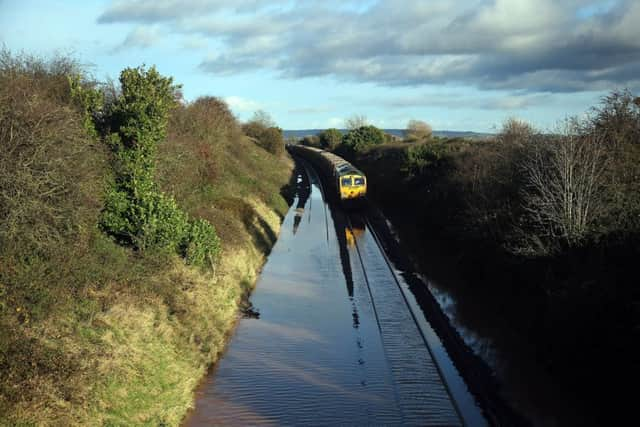David Spaven: Scotland needs higher quality freight diversion routes


The recent weather-related closures of the West Coast Main Line (WCML) at Lamington, and the Highland Main Line between Perth and Pitlochry, highlight Scotland’s vulnerability to a lack of top-quality diversionary routes for vital rail freight flows.
The WCML is by far the most important Anglo-Scottish rail freight artery, carrying domestic, European and Deep Sea traffic safely, swiftly and sustainably. But the disruption caused by damage to the Lamington Viaduct has forced rail hauliers to use diversionary lines which lack sufficient capability. The obvious alternative route to key destinations such as the West Midlands of England and major Deep Sea ports such as Liverpool and Southampton, is to run trains via the Glasgow-Kilmarnock-Dumfries-Carlisle line, reconnecting to the WCML at Carlisle. Although, unlike the WCML, it is not yet electrified, there is plenty of spare capacity on this route, with previously single-track sections doubled over the last 10 years – but the problem has been ‘loading gauge’, namely the ability to accommodate the modern-generation of tall and wide containers through tunnels and overbridges built in the Victorian era.
Advertisement
Hide AdAdvertisement
Hide AdThe Dumfries route normally only permits containers up to 8’6” high to be carried – unless special low-platform wagons are provided – but WCML trains are busy with 9’6” containers, the new international standard. Network Rail worked hard to improvise temporary enhanced arrangements via Dumfries and were able to give the green light for certain types of 9’6” high containers – although only shorter trains could use the route, impacting on rail costs.
Many container trains full of Scottish exports (in particular bottled whisky) have had to be routed via the East Coast Main Line (ECML), which is less restricted than the Dumfries route. But transit times to the south are longer from the key rail terminals at Grangemouth, Coatbridge and Mossend, in part because electrically-hauled freight trains have to thread their way through the busy Haymarket and Waverley passenger stations. There is an alternative way through Edinburgh – the South Suburban line – but it is still not electrified. Electrification of the South Suburban line would complement perfectly the completion later this year of loading gauge work by Network Rail which will give the ECML (and the South Suburban) full capability for 9’6” high containers.
Loading gauge clearance north of the Central Belt remains a patchwork of different capabilities, yet road hauliers face none of these complications, as the trunk road system has been massively upgraded to give ubiquitous passage for the likes of 9’6” containers.
And two-thirds of the Highland Main Line is still single-track, so intermodal trains are restricted to just 20 containers length – but with proper investment in double-tracking, these trains could be increased to 28-container length, a massive increase in rail productivity. However, the only confirmed Scottish Government investment along the Perth-Inverness corridor is £3bn expenditure on full dualling of the A9 road – with a similar sum to be lavished on the A96 road from Aberdeen to Inverness.
The recent two-week blockage of the Highland Main Line by flood damage meant that freight trains – including the daily Tesco container train from Mossend to Inverness – faced a diversion via Dundee and Aberdeen. Additional freight capacity is needed on the single-track Aberdeen-Inverness route, not only in terms of resilient diversionary capability , but also to enhance the prospects of shifting to rail substantial quantities of bulk whisky traffic which currently move entirely by road from Speyside to the Central Belt.
Enhancing rail freight’s capability and getting more trucks off the roads will not just be good for the Scottish economy, Scotland’s climate change targets and public safety – it will also save the Scottish Government substantial expenditure on road maintenance resulting from the heavy damage done to road surfaces by big lorries.
Road damage rises steeply with axle weight, and is widely acknowledged to be proportional to the fourth power of the axle weight.
This means that doubling the axle weight increases road damage 16 times, and in the case of the heaviest (44-tonne) trucks – the main competition for rail freight – HGVs are up to 160,000 times more damaging to road surfaces than the smallest vehicles. The vehicle taxation system does not reflect this massive disparity, so the biggest trucks are in effect being cross-subsidised by smaller trucks and cars.
Advertisement
Hide AdAdvertisement
Hide AdAnd the consequences for Scotland’s road system are all too apparent in the ruts forming along the inside lanes of dual carriageways with heavy freight flows, such as the A9 and A90.
Creating a level playing field for road and rail – including a robust network of diversionary rail routes to cope with the extreme weather events we now face – would transform rail’s capability to secure a very substantial transfer of freight from road haulage, to everyone’s benefit.
• David Spaven, Scottish Representative, Rail Freight Group